Design Visualization: Smoke and Mirrors
Below are the slides from (Part I and the first part of Part II) Ruth Malan's Design Visualization: Smoke and Mirrors (90 minute) talk at the Software Architect Conference in London on October 14, 2015.
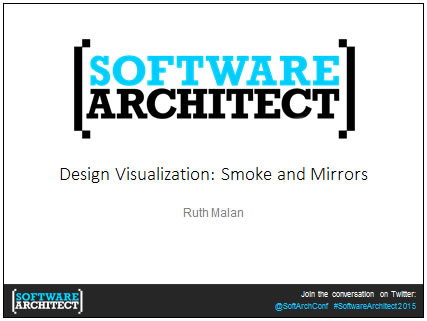 |
This is the part where I tell you "This flight is going to Indiana by way of South Africa. If you're on the wrong flight, this would be a good time to attend one of the awesome talks down the hall." My name is Ruth Malan -- I don't know how to pronounce it either, so any way you say it is fine. Well, as long as you're staying, let me tell you that Dana Bredemeyer says "There is a silver bullet in software engineering, and it is relationships of goodwill and a commitment to objectivity." There's a catch though. Those relationships take effort and attention to build and to sustain and grow. So here I am, relying on you to extend a little goodwill on credit to me, and as we proceed, I hope I'll earn a little more, as we talk about some ways we can work on objectivity.
|
 |
The M.C. Escher Company holds and protects their copyrights to M.C. Escher's work quite tenaciously. Not being able to reproduce Day and Night for you here, presents a little opportunity to demonstrate a point at the heart of this talk. Day and Night is one of Escher's more famous works, so you have likely seen it and I'd like you to call it again to mind. Do you see it in your mind's eye? It is the one where there is a town in the light, and a mirror image in the dark of night. A river runs by, in the light, and the night. There are fields that become abstractions that become duck (or geese), flying <gestures a mesh with interwoven fingers of both hands> from the light, others in mirror image out of the night. When you called it to mind, perhaps at first you were thinking of another Escher, or perhaps it struck you differently and you remembered different features. And that's the point, really. We don't know if what I call to mind, and see in my mind's eye is quite what you see, even if the original was the same image. Another point of salience in this context, is that it conveys a movement, a fluid interplay, between the concrete and abstract, between what is and what is mirrored. |
 |
And that is where we are headed -- to talk about design as intention, and reflection of design as realized, and how we express and envision our designs. But first I would like to revisit how we think of software architecture, and the role visual expression plays in design.
|
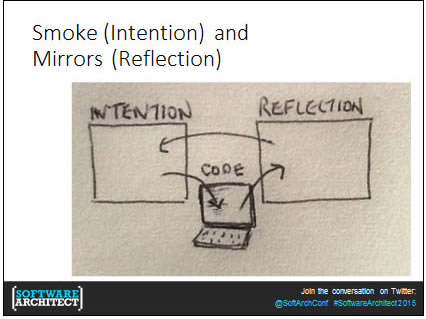 |
I playfully subtitled the talk "Smoke and Mirrors" -- for it can seem like we practice magic and sleights of hand when we don't expressly communicate our design intention, or reflect on the design as realized, in order to iterate on and improve our understanding of what we have, and intend.
|
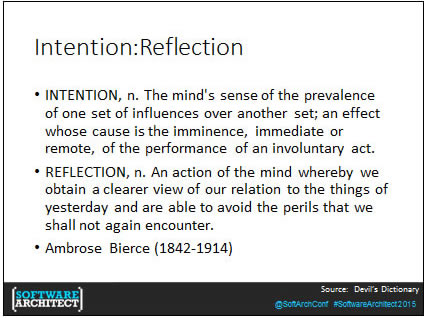 |
Here we have the definitions of intention and reflection from Ambrose Bierce's Devil's Dictionary. If you're not familiar with the Devil's Dictionary, it gives definitions a cynical side-eye, helping us understand something better by looking at the (negative) space left by contact of the concept with reality, and what that defines. Intention, then, is what we get, despite our intention -- an involuntary act. It is a big wink at our bias and foible and self delusions and intellectual aggrandizements. As for reflection: "An action of the mind whereby we obtain a clearer view of our relation to the things of yesterday and are able to avoid the perils that we shall not again encounter." That so well captures the weltanschauung of our day and field -- we forget, of course, that it was Heraclitis who said "Change is the only constant." Now, when it comes to definitions I'm on the same page as Richard Feynman when he said: 'We can't define anything precisely. If we attempt to, we get into that paralysis of thought that comes to philosophers… one saying to the other: “you don't know what you are talking about!”. The second one says: “what do you mean by talking? What do you mean by you? What do you mean by know?”' Undeterred, we're going to take a look at the definition of software architecture. |
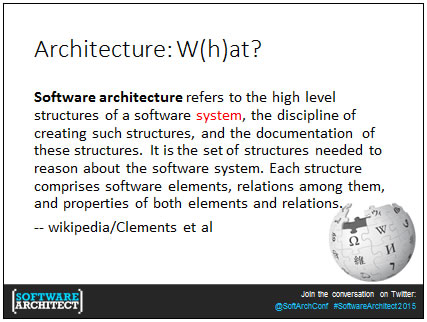 |
This is the definition from the touchstone of our era, wikipedia. When I see a definition, especially in a context like this, I tend to see it as words words words.. words words. So I helped a little to lead attention from software architecture to system. What do we mean by system?
|
 |
Dana Meadows characterized a system as "an interconnected set of elements that is coherently organized in a way that achieves something."
|
 |
Returning to Paul Clements and colleagues definition on wikipedia, we note "high level structures" -- comprising elements and relations, along with properties. High level? |
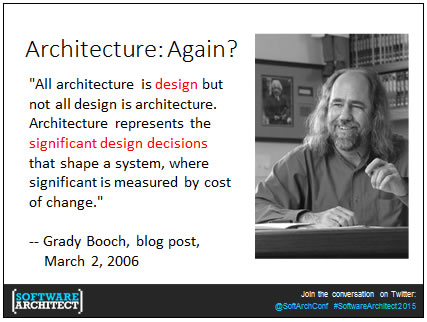 |
Grady Booch memorably observed "All architecture is design, but not all design is architecture. Architecture represents the significant design decisions" Decisions?! |
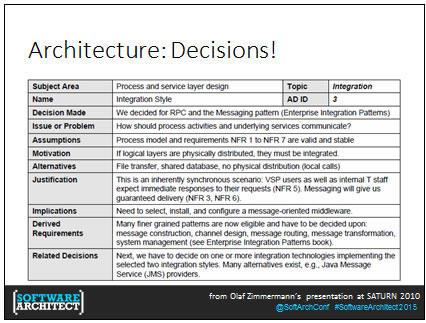 |
We know what to do with decisions! We'll name them, describe them, identify what problem the decision addresses and the forces we're weighing to harmonize, resolve and balance. We'll keep track of assumptions we're making, explicitly identifying what in the context we presume to be stable and what to watch. We'll connect the dots to the business rationale and technical goals we're trying to achieve, or the hard-(l)earned scars of experience we're seeking to avoid this time round. We'll outline alternatives we considered but ruled out, so we don't have to revisit those arguments again and again. And we'll note implications so we -- our teams and those we collaborate with -- can be prepared. Then we'll consider what further requirements are implied by, or derive from this decision we're making and documenting. And identify related decisions we need to make next... Decisions are central, and it is a great template, but you can just hear the captain in the cockpit yelling "pull up, pull up" -- we'll run into a veritable forest of decision trees if we speed too far too fast down that runway just now. |
 |
Which decisions? Design decisions. Design! |
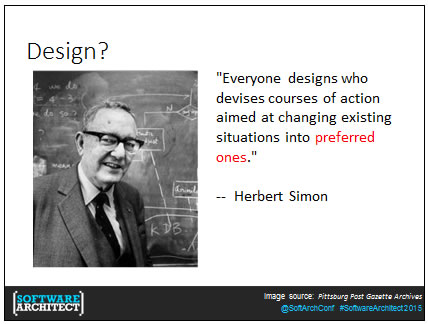 |
Herbert Simon, according to Jabe Bloom, is "ground zero in design discourse." And this is quintessential Herb: "Everyone designs who devises courses of action aimed at changing existing situations into preferred ones." |
 |
A variation on the theme: "The engineer, and more generally the designer, is concerned with how things ought to be - how they ought to be in order to attain goals, and to function." |
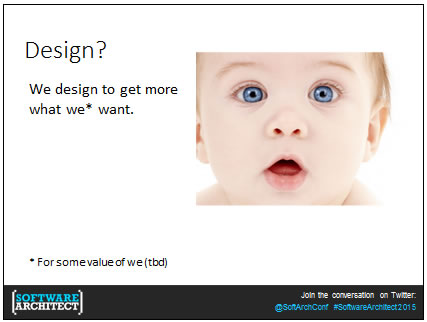 |
And that is just one of those so precious moments when the world is full of simple wonder again -- we design to get more what we want. |
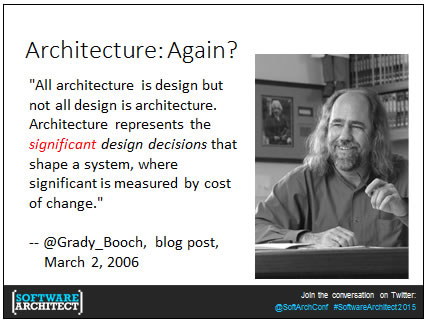 |
Returning to the eminent Mr. Booch: "Architecture represents the significant design decisions" |
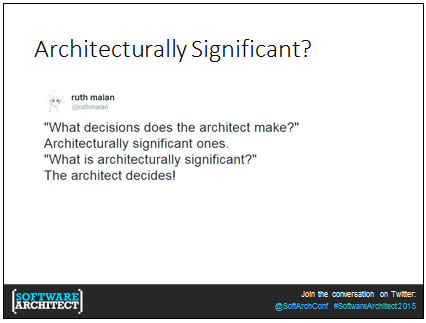 |
"What decisions does the software architect make?" The architecturally significant ones. "What is architecturally significant?" The architect decides! The architect decides. That sounds like a tautology, but it really is the crux of the matter. |
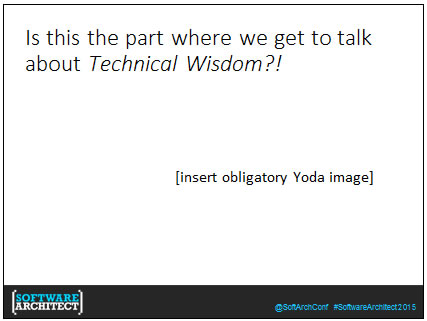 |
Is this the part where we get to talk about technical wisdom? |
 |
No, this is the part where we get to say "Awww" Just kidding. |
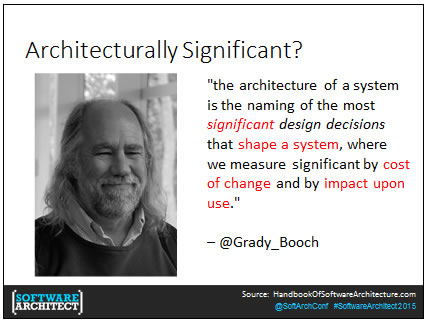 |
Technical wisdom factors. Factors in and factors out. What is shapingly crucial? |
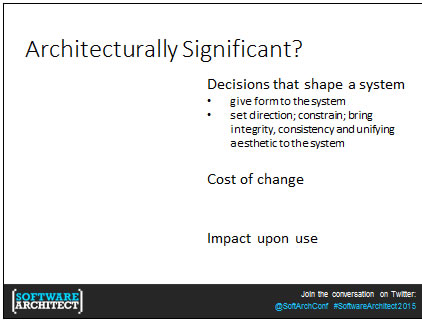 |
Ok, so if architecture is a set of decisions, but not all decisions, and we're asking which belong in the architecture, we're looking for those that shape, that
And those that have the highest cost of change. Decisions which would incur substantial
to change or revert and rework, are architecturally significant. Also, if a decision meaningfully reduces the cost of making changes, enabling our business to be more fleet, adapting and extending its services or product set as the market shifts, it is architecturally significant. |
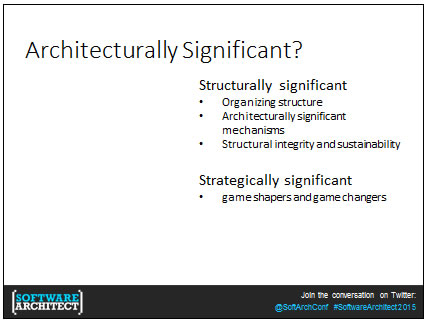 |
Those are important insights, but I would like to add: architecture decisions are structurally significant. They deal with the organizing structure of the system and the design of architecturally significant mechanisms to yield desired system outcomes, including system properties, while addressing inherent challenges. Structurally significant. You know, make or break. And strategically significant. "Software is eating the world" (Marc Andreessen). Software enables. And more, across industries, software is increasingly a source, if not the source, of differentiation. It is game shaping and game changing.
|
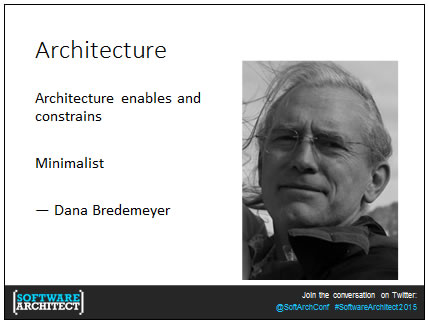 |
Software systems are in place -- for 3 months, 3 years, 10 years. 20. Because they enable something our business depends on. But, increasingly, and more as systems age and the architecture erodes under the weight of accommodations and agglomerations, these systems constrain the business, impede agility and adaptability and responsiveness to an ever shifting context. And architecture, the critical decisions that hold the system up and tie it down, in turn enables and constrains the code (and those who write it). Architecture decisions create the context for further decisions, reducing -- cleaving -- the decision space. This is good. It reduces the overload of overwhelming ambiguity and uncertainty, creating "ground under the feet" (Dana Bredemeyer) that we can move forward on. Critical decisions take time to make attentively and can be fraught with downstream consequences if made inattentively and without foresight. And this is bad, if it takes decisions away, reduces empowerment or degrees of freedom and motivation, where it matters. So we seek to keep our architecture decisions, in Dana Bredemeyer's urging, to a minimal set. |
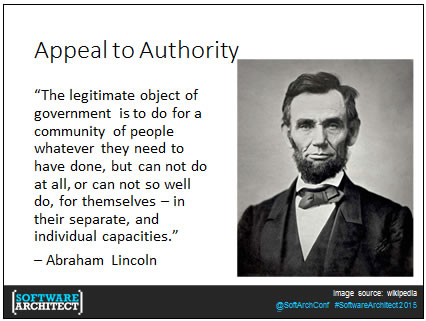 |
To reach a helpful notion of what, then, we consider architecturally significant, Dana points to Daniel Day-Lew--er(r) Abraham Lincoln: "The legitimate object of government is to do for a community of people whatever they need to have done, but cannot do at all, or cannot so well do, for themselves, in their separate and individual capacities. In all that the people can individually do as well for themselves, government ought not to interfere." |
 |
Architecture decisions are those that impact system outcomes. That is, outcomes that can't be ascribed to locally-scoped parts of the system. Intentional architecture decisions are those, from a standpoint of experience, we deem must be made from a system perspective, to get more what we want from the system. More than we would get, if we left the decision to be made at a more narrow scope with only local information about the forces that impinge upon, and outcomes that are contingent on, the decision. That is, architecture decisions are those that need to be made across boundaries -- the system boundary, and boundaries within the system, in order to achieve desired system outcomes -- to meet system goals with more the system properties we want. Properties like usability or performance that the user cares about. Properties like resilience and scalability that the ops team cares about. Properties like understandability and adaptability that the dev team cares about. Properties that emerge from interactions and relations among elements, rather than localized concerns. |
 |
Of course, despite our best intentions, some implicit decisions will prove to be architecturally significant. The point is, do we want to leave matters of system integrity and strategic import to accident, or do we want to bring what we can to bear, to get more what we want?
|
Part II: Visual Design; Section A: Leonardo da Vinci and the case for sketching
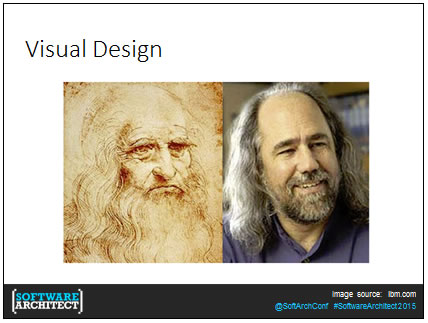 |
When I googled to find an image of Grady for the previous slide, this was one of the results. It's on an IBM site related to a conference, and next to the image of Da Vinci and Booch there is the playful caption "separated at birth?" The relationship, at least in my view, has to do visual design, for Grady Booch is one of the fathers of visual design in software. While Leonardo da Vinci is one of the fathers of visual design in engineering. |
 |
Anyway, I thought the image was a neat serendipity because when I was collaborating with Grady Booch on software visualization several years ago, Grady introduced me to this book: Engineering and the Mind's Eye. Which in turn introduced me to Da Vinci as engineer. Of course, I was familiar with Da Vinci's work as artist -- even privileged to see his cartoon (as a full-size preparatory study for a painting is known) of the Virgin and Child (with St Anne and St John the Baptist) in the National Gallery. I'd seen his sketches of imaginative flying machines and was aware of his notebooks. |
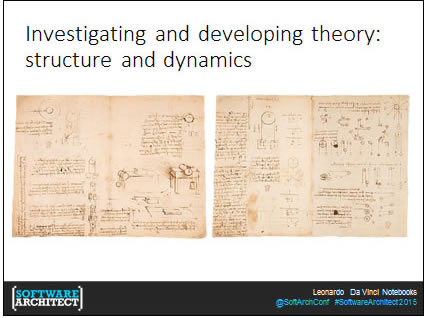 |
But I hadn't explored the extent, manner and contribution of his work in engineering. Now this Renaissance man would be inspiring in any event, but additionally so in this context, for he used sketches to investigate, to find out, to create visual "demonstrations" that teach. He puzzled things out, to astonishing effect. Da Vinci foreshadowed Copernicus by 40 years, declaring "IL SOLE NO SI MUOVE" ("The sun does not move.") He added, "The earth is not in the center of the circle of the sun, nor in the center of the universe." And 200 years before Newton, he wrote "Every weight tends to fall towards the center by the shortest possible way." He was likewise prescient in other fields. 400 years before Darwin, he placed man in the same broad category as apes.[Gimpao Ni Ei Suuh] We may know him as a painter and sculptor, but he was esteemed in his day not just for art—holding official positions as engineer including "painter and engineer to the Duke", and “First painter, architect, and engineer to the King.” Leonardo was intrigued by problems like inertia, friction and resistance, and investigated mechanisms and mechanical elements such as screws and gears, pulleys and weights, with a piqued visual curiosity. Though his scientific notes are articulate and precise, for Leonardo, illustration took precedence—the drawing does not illustrate the text; rather, the text serves to explain the picture. To this end, he developed principles of graphic representation—stylization, patterns, and diagrams. |
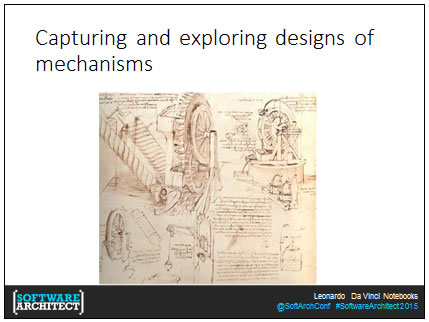 |
Indeed, he developed and practiced a rather modern form of cognition—studying what was known from masters current and past (his library was extensive), but extending that study by "knowing how to see" (saper vedere) with scientific inquiry augmented and abetted by technology—that of pen/pencil. He and other engineers of the day would study each other's works. |
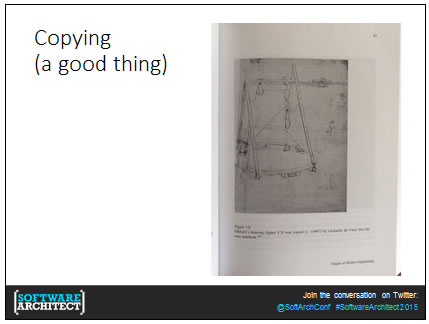 |
And they copied designs from each other's notebooks (Engineering and the Mind's Eye). |
 |
Leonardo's notebooks capture and extend understanding of phenomenon of nature and machine, and include numerous inventions, some built in his time, others later -- such as the lens grinding machine pictured. These inventions, we might note, were constructed as sketch-prototypes so compellingly drawn as to both persuade feasibility in many cases, and to inform construction. (The Archimedes steam cannon is a fun story). |
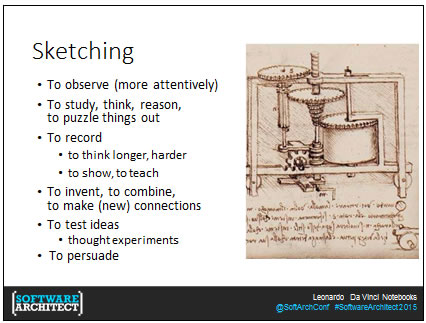 |
Leonardo's notebooks stand testimony to sketching as a means to
|
Part II: Visual Design -- in progress.
URL: http://www.bredemeyer.com
Page Created: October 29, 2015
Last Updated: October 29, 2015